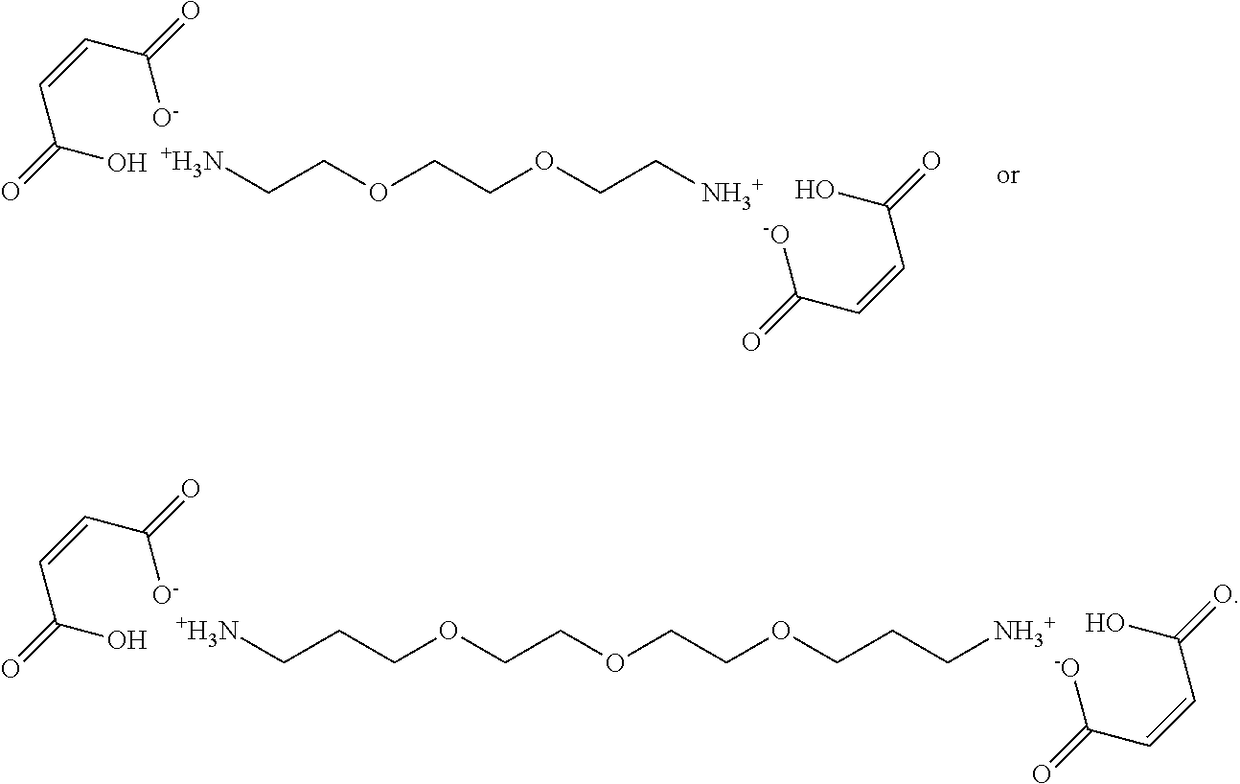Methods and formulations for curling hair
a technology of curling hair and hair, applied in the field of curling hair formulations and methods, can solve the problems of hair strength reduction and hair loss through breakage, and achieve the effects of improving appearance, reducing hair loss, and increasing dry strength
- Summary
- Abstract
- Description
- Claims
- Application Information
AI Technical Summary
Benefits of technology
Problems solved by technology
Method used
Image
Examples
example 1
f Asian Hair
[0254]Composition of Formulations 1 & 2:
[0255]Formulation 1 contained 2 wt % NaOH and 2 wt % Bis-Aminopropyl Diglycol Dimaleate with the remainder of the formulation being made up of water.
[0256]Formulation 2 contained 4 wt % Bis-Aminopropyl Diglycol Dimaleate with the remainder of the formulation being made up of water.
[0257]Curling Procedure:
[0258]Formulation 1 was prepared immediately prior to use and applied to a swatch of Asian hair in a perm roller and allowed to sit for 20 minutes. The hair sample was then thoroughly rinsed with room temperature water for 3 minutes and then blotted with a paper towel. Formulation 2 was added to the hair sample and allowed to sit for 20 minutes. The hair sample was then rinsed, removed from the roller, shampooed and conditioned and allowed to air dry.
[0259]Curling Results:
[0260]The hair retained a curl and exhibited a better condition, as compared to the hair prior to treatment, such as increased smoothness and shine.
[0261]Curl ret...
example 2
f Asian Hair
[0262]Composition of Formulations 1 & 2:
[0263]Formulation 1 contained 2 wt % NaOH with the remainder of the formulation being made up of water.
[0264]Formulation 2 contained 4 wt % Bis-Aminopropyl Diglycol Dimaleate with the remainder of the formulation being made up of water.
[0265]Curling Procedure:
[0266]Two swatches of Asian hair were rolled into perm rollers and each swatch was treated with Formulation 1 for 20 minutes. Both hair swatches were then rinsed for 3 minutes and blotted with a paper towel. One of the swatches was then treated with Formulation 2 for 20 minutes and the other swatch was treated with a 5 wt % acetic acid aqueous solution for 20 minutes. Both swatches were then rinsed, removed from the perm rollers, shampooed and conditioned and allowed to air dry.
[0267]Curling Results:
[0268]The hair swatch neutralized with Formulation 2 demonstrated curl retention but was in worse condition than prior to the treatment and in significantly inferior condition, whe...
example 3
f Caucasian Hair
[0270]Composition of Formulations 1 & 2:
[0271]Formulation 1 contained 2 wt % NaOH and 4 wt % Bis-Aminopropyl Diglycol Dimaleate with the remainder of the formulation being made up of water.
[0272]Formulation 2 contained 4 wt % Bis-Aminopropyl Diglycol Dimaleate with the remainder of the formulation being made up of water.
[0273]Curling Procedure:
[0274]Formulation 1 prepared immediately prior to use and applied to Caucasian hair in a perm roller and allowed to sit for 20 minutes. The hair sample was then thoroughly rinsed in room temperature water for 3 minutes and blotted with a paper towel. Formulation 2 was added to the hair sample and allowed to sit for 20 minutes. The hair sample was then rinsed, removed from the perm roller, shampooed and conditioned and allowed to air dry.
[0275]Curling Results:
[0276]The treated hair retained curl and exhibited a better condition, as compared to the hair prior to treatment, such as increased smoothness and shine. Curl retention wa...
PUM
| Property | Measurement | Unit |
|---|---|---|
| pH | aaaaa | aaaaa |
| pH | aaaaa | aaaaa |
| wt % | aaaaa | aaaaa |
Abstract
Description
Claims
Application Information
 Login to View More
Login to View More - R&D
- Intellectual Property
- Life Sciences
- Materials
- Tech Scout
- Unparalleled Data Quality
- Higher Quality Content
- 60% Fewer Hallucinations
Browse by: Latest US Patents, China's latest patents, Technical Efficacy Thesaurus, Application Domain, Technology Topic, Popular Technical Reports.
© 2025 PatSnap. All rights reserved.Legal|Privacy policy|Modern Slavery Act Transparency Statement|Sitemap|About US| Contact US: help@patsnap.com



